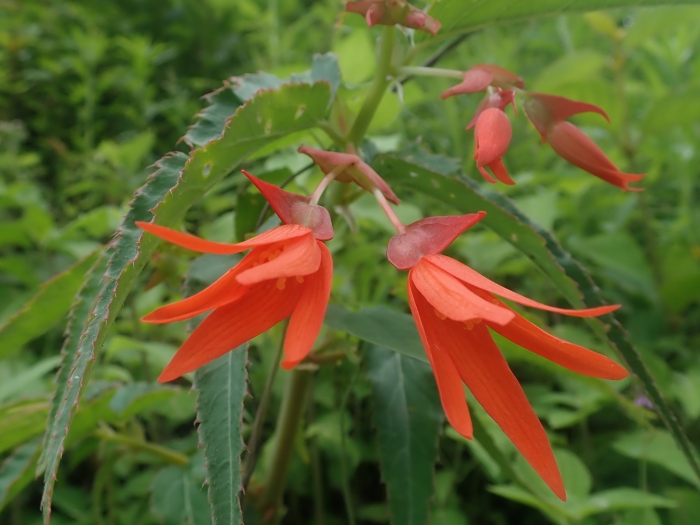Bolivian Begonia
(Begonia boliviensis)
Bolivian Begonia (Begonia boliviensis)
/
/

Nolan Exe
CC BY 4.0
Image By:
Nolan Exe
Recorded By:
Copyright:
CC BY 4.0
Copyright Notice:
Photo by: Nolan Exe | License Type: CC BY 4.0 | License URL: http://creativecommons.org/licenses/by/4.0/ | Rights Holder: Nolan Exe | Publisher: iNaturalist | Date Created: 2019-11-27T10:25:43-08:00 |














Estimated Native Range
Summary
Begonia boliviensis, commonly known as Bolivian Begonia, is a deciduous perennial herb that is native to the Yungas cloud forests of the Andes in Bolivia and Argentina. This species thrives in the moist, cool conditions of mountainous regions, often found in shaded areas with high humidity. It typically reaches a height of 12 to 18 inches (30 to 46 cm) and is noted for its striking drooping scarlet flowers. The plant features bright-orange, bell-shaped flowers that bloom profusely from late spring through summer, creating a vibrant display. The foliage is serrated with a red margin, adding to its ornamental appeal.
Bolivian Begonia is celebrated for its beautiful, showy flowers and is often used in hanging baskets, containers, and as a border plant in shady garden spots. It requires consistent moisture and does not tolerate drought well. Gardeners should provide it with high amounts of water and ensure it is planted in well-draining soil to prevent root rot. While it can tolerate full sun in cooler climates, it generally prefers part shade, especially in hotter regions. Begonia boliviensis can be susceptible to powdery mildew and requires good air circulation to minimize this risk. It is not known for being invasive but should be protected from frost to survive in temperate gardens.CC BY-SA 4.0
Bolivian Begonia is celebrated for its beautiful, showy flowers and is often used in hanging baskets, containers, and as a border plant in shady garden spots. It requires consistent moisture and does not tolerate drought well. Gardeners should provide it with high amounts of water and ensure it is planted in well-draining soil to prevent root rot. While it can tolerate full sun in cooler climates, it generally prefers part shade, especially in hotter regions. Begonia boliviensis can be susceptible to powdery mildew and requires good air circulation to minimize this risk. It is not known for being invasive but should be protected from frost to survive in temperate gardens.CC BY-SA 4.0
Plant Description
- Plant Type: Herb
- Height: 0.5-2 feet
- Width: 1-1.5 feet
- Growth Rate: Moderate
- Flower Color: Orange, Red
- Flowering Season: Fall, Spring, Summer
- Leaf Retention: Deciduous
Growth Requirements
- Sun: Part Shade
- Water: Medium
- Drainage: Medium
Common Uses
Bird Garden, Border Plant, Butterfly Garden, Groundcover, Hummingbird Garden, Potted Plant, Showy Flowers, Street Planting
Natural Habitat
Yungas cloud forests of the Andes in Bolivia and Argentina
Other Names
Common Names: Boliviabegonia
Scientific Names: , Begonia boliviensis, Begonia boliviensis var. latitepala, Begonia argentinensis,
GBIF Accepted Name: Begonia boliviensis A.DC.